 Web Content Viewer
Web Content Viewer
Nature-Based Solutions
Jan 1, 2024


According to the International Union for Conservation of Nature (IUCN, 2016), SbN is an umbrella concept that includes all actions of protection, restoration and sustainable management of natural or modified ecosystems, which simultaneously provide benefits to human well-being and biodiversity, to respond to the most pressing socio-environmental challenges, such as food security, water security, climate change, disaster risk, biodiversity loss, human health, among others.
The nature-based solutions axis seeks to protect Biodiversity and Ecosystem Services in strategic areas, as well as improve the livelihoods of local communities. The main lines of action of this axis are: Ecoreservas, Natural Climate Solutions and Tree Planting.
Ecoreserves
Ecoreserves are "geographically defined areas owned by companies of the Ecopetrol Group, which are voluntarily designated in part or completely to the conservation of biodiversity and the supply of ecosystemic services, without limiting their productive purposes".
The Ecoreserves Network accounts for 20 designated areas in different parts of the country, with approximately 15,583 hectares destined for conservation. The Network allows to evidence the coexistence of operations and nature in harmony.
Of the 20 Ecoreserves designated in the Ecopetrol Group, twelve (12) belong to Ecopetrol S.A., five (5) to Cenit, two (2) to Ocensa and one (1) to Hocol.
Ecopetrol's designated Ecoreserves in collaboration with the Alexander von Humboldt Institute.
Up until now there are ten (10) *Biodiversity Management Plans, which will allow us to carry out activities that aim to improve the offer of ecosystem services and Biodiversity within the following years.
*Biodiversity Management Plans: these are a planning instrument that guides the management of each of these areas to achieve specific conservation results.
Types of ecoreserves
There are five (5) types of Ecoreserves that determine the way in which they relate to the activities of the Ecopetrol Group, described in the following image:
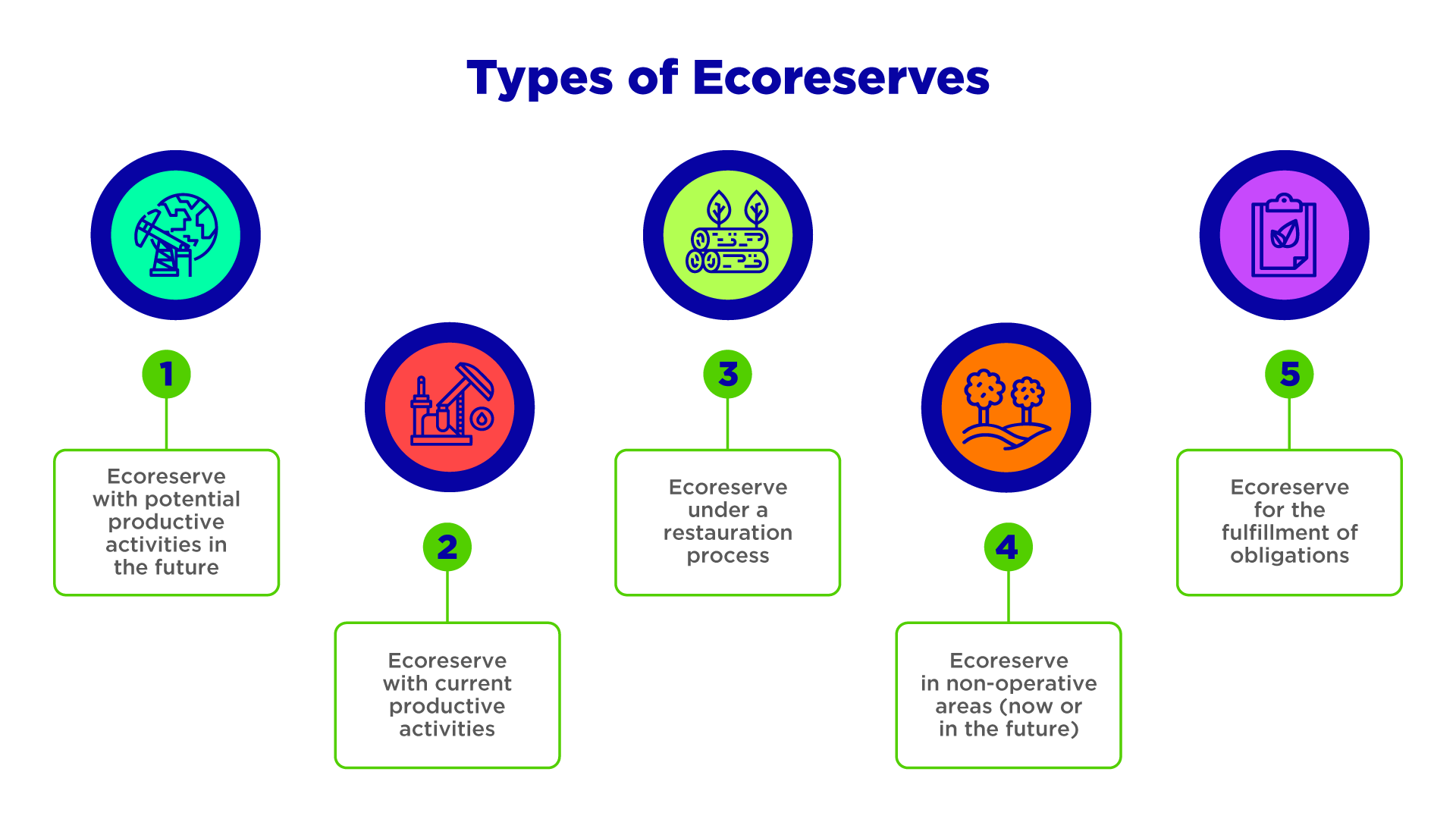
Ecoreserves with implemented Biodiversity and Management Plans
Of the twenty (20) Ecoreserves designated at the end of 2023, ten (10) have Biodiversity Management Plans prepared through the “FIBRAS” agreement (Alexander von Humboldt Institute and Ecopetrol S.A.) and the “ECORESERVAS” agreement (Alexander von Humboldt Institute, Cenit and Ecopetrol S.A.).
Additionally, these ten (10) Ecoreserves have an images and sounds catalog of the different species that inhabit these ecosystems, thanks to the study of their fauna and flora. Below, you can learn more about the characteristics and species in each one of these Ecoreserves:
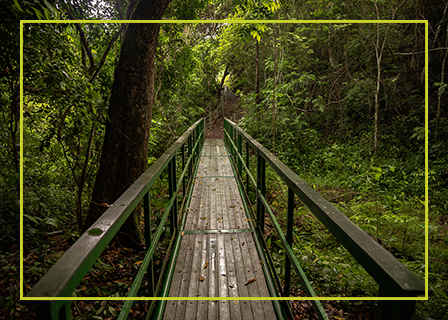 La Tribuna Ecoreserve · Huila, Neiva
La Tribuna Ecoreserve · Huila, Neiva
-
Tropical dry forest, a highly threatened ecosystem in Colombia, unique in the area.
-
Water richness and natural hydrocarbon upwelling in the Neme stream.
-
Learn about and listen to the species found in this ecoreserve: La Tribuna Ecoreserve images and sounds catalog.
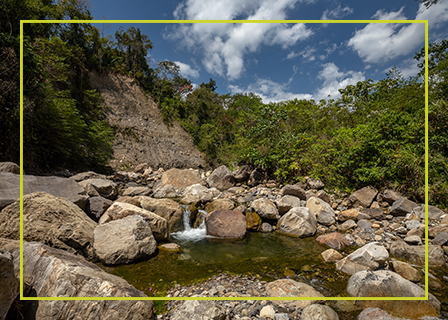
El Tucán Ecoreserve · Casanare, Aguazul
-
High number of bird species recorded at the site, which gives it potential for birdwatching tourism.
-
A highlight of the site is the variety of ants found.
-
Learn about and listen to the species found in this ecoreserve: El Tucán Ecoreserve images and sounds catalog.
-
View the Biodiversity and Strengthening Plan for the El Tucán Ecoreserve.
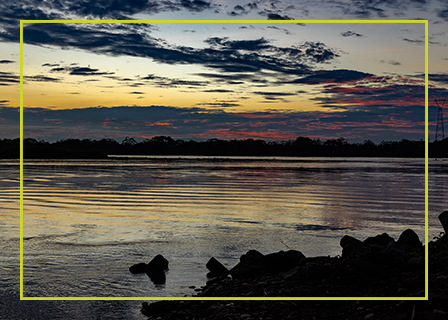
La Doncella Ecoreserve · Bolívar, Cantagallo
-
Unique in its class, located on an island in the middle of the Magdalena.
-
Potential to work on water issues and livelihoods related to fishing and navigation, which presents challenges and opportunities in green business and conservation.
-
Learn about and listen to the species found in this ecoreserve: La Doncella Ecoreserve images and sounds catalog.
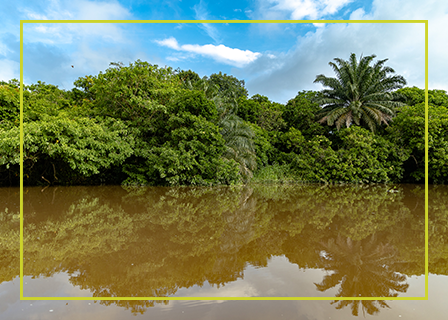
Centenario La Pácora Ecoreserve · Santander, Barrancabermeja
-
Its conservation management will complement existing regional efforts, such as the Ciénaga de San Silvestre Integrated Management District, among others.
-
It has tourist potential for navigation in rivers and marshes for bird and primate watching.
-
Learn about and listen to the species found in this ecoreserve: Centenario La Pácora Ecoreserve images and sounds catalog.
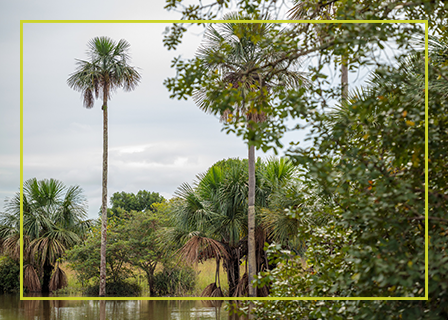
La Danta Ecoreserve · Meta, Puerto Gaitán
-
It is the most extensive Ecoreserve, covering nearly 10 thousand hectares.
-
Presence of Ocarros and Dantas, animals in danger of extinction. The highlands of this area is a unique ecosystem home for deers, anteaters, anteaters, palm bears and other mammals.
-
Learn about and listen to the species found in this ecoreserve: La Danta Ecoreserve images and sounds catalog.
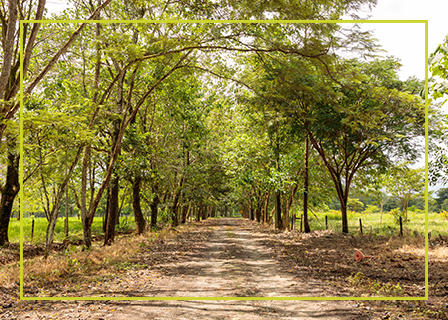
ASA La Guarupaya Ecoreserve · Meta, Acacías
-
This area allows the reuse of water.
-
A highlight of the area is the variety of primates and butterflies found.
-
Learn about and listen to the species found in this ecoreserve: ASA La Guarupaya Ecoreserve images y sounds catalog.
Mansilla Ecoreserve · Cundinamarca, Facatativá
-
Important record of biodiversity of flora species within the area, which gives it a potential in landscaping and biodiversity research.
-
This Ecoreserve provides critical habitats for the diversity of species of importance to ecosystem.
-
Learn about and listen to the species found in this ecoreserve: Mansilla Ecoreserve images y sounds catalog.
-
View the Biodiversity and Strengthening Plan for the Mansilla Ecoreserve.
La Sabana Ecoreserve · Cundinamarca, Tocancipá
-
The Ecoreserve is shaped by historic anthropic activities, due to the transformation of its landscape, it offers an opportunity to generate research spaces and thus carry out restoration, recovery and rehabilitation processes.
-
Learn about and listen to the species found in this ecoreserve: La Sabana Ecoreserve images y sounds catalog.
Bosque Seco Tropical Ecoreserve · Córdoba, San Antero
-
The different aquatic ecosystems present in the Ecoreserve play a fundamental role in the regulation and provisioning of fresh water, which allows for a continuous supply throughout the year.
-
An outstanding element is the presence of one of the largest felines in Colombia, the Ocelot (Leopardus pardalis), which is an important specie for the maintenance of the ecosystem.
-
Learn about and listen to the species found in this ecoreserve: Bosque Seco Tropical Ecoreserve images y sounds catalog.
El Zocay Ecoreserve · Meta, Villavicencio
-
This Ecoreserve has the highest number of bird species among the Ecoreserves, which gives it potential for observation and scientific tourism.
-
A highlight is the presence of the spotted frog (Boana punctata), which has the ability to change the color of its skin and plays a key role in the ecosystem as a biological controller.
-
Learn about and listen to the species found in this ecoreserve: El Zocay Ecoreserve images y sounds catalog.
Biodiversity in the Ecoreserves
Of 10 Ecoreserves studied through biodiversity monitoring, the following data associated with biological groups were identified:
| Biodiversity monitoring results summary first 10 Ecoreserves | ||||||||||
|---|---|---|---|---|---|---|---|---|---|---|
|
Biological Groups |
Tribuna Ecopetrol | Tucán Ecopetrol | ASA Ecopetrol | La Danta Ecopetrol | La Doncella Ecopetrol | Centenario La Pácora Ecopetrol | El Zocay Ecopetrol | San Antero Cenit | Tocancipá Cenit | Mansilla Cenit |
|
Reptiles |
13 |
13 |
19 |
12 |
12 |
18 |
15 |
21 |
1 |
4 |
|
Insects |
56 |
161 |
112 |
128 |
63 |
77 |
165 |
67 |
6 |
28 |
|
Fishes |
3 |
30 |
74 |
75 |
36 |
31 |
67 |
2 |
2 |
3 |
|
Amphibians |
10 |
18 |
15 |
19 |
10 |
17 |
18 |
16 |
1 |
3 |
|
Birds |
121 |
170 |
153 |
174 |
132 |
135 |
136 |
127 |
24 |
82 |
|
Mammals |
9 |
23 |
16 |
18 |
8 |
20 |
24 |
29 |
2 |
16 |
|
Plants |
140 |
165 |
148 |
186 |
70 |
118 |
286 |
138 |
96 |
333 |
|
Total |
352 |
580 |
537 |
612 |
331 |
416 |
711 |
400 |
132 |
469 |
Recognition of the Ecoreserves Network
In 2023, Ecopetrol was awarded the “Boscar” Prize by the Mexican NGO Reforestamos. This recognition is awarded to companies that have programs to conserve and improve forests promoting sustainable development. On this occasion the initiative that was awarded to the Ecoreservas iniative.
In 2022, Red Colombia of the United Nations Global Compact and the Bogota Chamber of Commerce awarded recognition for good sustainable development practices to the Ecopetrol Group's Ecoreserves Network initiative, for its contribution to Sustainable Development Goal 15.

“This recognition is an additional motivation to continue working on the implementation of practices that respond to the environmental and social challenges we face today as a society. The Ecoreservas initiative, in addition to being a pioneer in the industry at national and international level, has great potential to conserve our biological wealth and generate well-being for the surrounding communities".
- Santiago Martínez, Head of Sustainability and Decarbonization, Ecopetrol.
Nature-Based Solutions Platform
The NbS Platform is a tool developed by TNC and Ecopetrol to strengthen the environmental management capacities of multiple institutional actors, both in the public and the private sector. It seeks to facilitate access to information and contribute to the preparation, formulation, planning, implementation and monitoring of projects that positively impact comprehensive metrics associated with water security, climate change mitigation and biodiversity conservation.
What can be achieved with the NbS Platform?
We hope that planners, environmental authorities, project formulators, academia, consultants and private investors will benefit from the contents of the Platform for the construction of NbS projects. The platform has three main services:
- Toolboxes with conceptual and methodological resources (guides, maps, protocols) that technically guide the construction of the different stages of the NbS project cycle (preparation, formulation, planning, implementation and monitoring).
- Library with international success stories and informative videos on Nature-based Solutions.
- NbS selection assistant to relate the system with areas of implementation, environmental issues or socio-environmental challenges, including climate change, water security. The latter is useful in light of consultation procedures that require data bases to identify the most appropriate NbS.
Check the Nature Based Solutions Platform.
Contributions to ecological restoration

The Business Group joined the initiative - 1t.org - whose objective is to mobilize, connect and empower the global reforestation community to conserve, restore and cultivate one billion trees by 2030.
Find more about Ecopetrol's commitment.
The Ecopetrol Group's goal was to plant 6 million trees in the period 2018-2023 and 12 million trees accumulated by 2030. At the end of 2023, the Ecopetrol Group internally recorded a total of 8.063.226 trees planted, delivered, and supported in conjunction with its partners. See table with records in the Our ambition section.
The report of information to the Respira 2030 program of the Ministry of Environment and Sustainable Development is made individually by each of the companies of the Ecopetrol Group, without taking into account the trees that some allies upload directly to the counter of the Respira 2030 platform. For this reason, the total number of trees registered internally by the Ecopetrol Group exceeds the data reflected on the Respira 2030 web page. For more information about this government program go to: https://www.respira2030.gov.co/.
Natural Climate Solutions
Natural Climate Solutions are a type of Nature-Based Solution, and correspond to actions that avoid greenhouse gas (GHG) emissions and increase carbon storage in forests, grasslands and wetlands. Some of these solutions include:
 Protection in critical ecosystems such as:
Protection in critical ecosystems such as:
- Forests
- Wetlands
- Grasslands
 Integrated management of:
Integrated management of:
- Timber forests
- Grazing lands
- Cropland
Ecological restoration of:
- Forests
- Wetlands
Restoration not only returns forests to a healthy state, but also increases the amount of carbon sequestered, improves biodiversity and soil and water quality in the ecosystem, and provides economic benefits to the communities that depend on that forest. World Economic Forum, 2021.
CO₂e avoidance initiatives:
- Avoided deforestation
- Improved agricultural crops, trees on agricultural land.
- Wetland and moorland conservation
Initiatives to capture CO₂e:
- Reforestation and afforestation
- New agricultural technologies
- Restoration of wetlands and moorlands
Portfolio of Natural Climate Solutions
The Greenhouse Gas offset portfolio is based on the Natural Climate Solutions prioritized for Ecopetrol’s Bussiness Group, with the greatest potential to reduce emissions and carbon quantification methodologies endorsed by certification programs. In case new methodologies are developed, these solutions can and will be incorporated into the portfolio.
Ecopetrol and The Nature Conservacy (TNC) structured the SNC portfolio with the purpose of recognizing projects with high potential for mitigation and compensation, to support Ecopetrol's Decarbonization Plan. The selection criteria for projects that are part of the SNC portfolio are:
| 1. The most cost-effective CNS pathways prioritized for Colombia by TNC | ||||||||
|
|
||||||||
| 2. Potential mitigation validation by forest type Deforestation avoided (REDD+) | ||||||||
|
 |
|||||||
| 3. Planting trees on agricultural land (silvopastoral and agroforestry) | ||||||||
|
||||||||
Additionally, other aspects are considered, such as:
- Location in areas of strategic interest
- Social and environmental cost-benefits
- Developers with extensive experience, knowledge, technical and financial execution capacity
- Risk management associated with the implementation of the type of initiatives, technical, financial, and legal execution
Role of Natural Climate Solutions in the Energy Transition
- Natural Climate Solutions play a key role in the energy transition, as they not only generate carbon credits, but also additional benefits that improve the socio-ecological conditions of the areas where they are implemented.
- They include reforestation, afforestation, restoration and sustainable land management activities, which help offset GHG emissions in energy and other sectors.
- They contribute to climate resilience by providing key ecosystem services that are important for climate change adaptation.
REDD+ MAGDALENA VALLEY
- Conservation and restoration of forests and wetlands in Santander and Antioquia
- 19.000 ton of CO₂e anually*
WILDLIFE PROJECT · PVS
- Conservation and restoration of floodplains in Piedemonte Andino-Amazonico and Magdalena Medio basin
- 32.000 ton of CO₂e anually*
ORINOCO CARBON
- Prevention of the transformation of natural ecosystems, as a strategy to encourage the conservation of biodiversity in the highlands of the Colombian Orinoquia
- 570.000 ton of CO₂e anually*
TNC CARBON SURVEY PROTOCOL
- Restoration projects in Meta and Caquetá with planting of trees and carbon monitoring
- Planting 250.000 trees
CARBON AND WETLANDS
- Restoration of ecosystems and carbon monitoring in Magdalena Medio wetland ecosystems
- 558.000 ton of CO₂e anually*
BLUE AND GREEN CARBON BIOGEOGRAPHICAL CHOCÓ
- Reduction of emissions or avoided GHG emissions in agriculture, forestry and other land uses
- Avoided deforestation of approximately 4.000 hectares and 1.6 million tons of CO₂e avoided/reduced*
SOUTH POLE
- Performs strategic review of the NCS portfolio
- Executes project due diligence processes
- Supports the maturation of new opportunities
- Supports NCS carbon credit portfolio management process
 CENTER FOR INNOVATION AND TECHNOLOGY · ICP
CENTER FOR INNOVATION AND TECHNOLOGY · ICP
- Generate scientific knowledge for the management of barriers that originate sources of uncertainty in the estimation of carbon stocks and fluxes in ecosystems and sustainable production systems
Implementation of Natural Climate Solutions projects to enable supply
Ecopetrol employs different actions to enable the supply of NCS projects, which include: methodologies, protocols, baselines, early investment in Natural Climate Solutions projects.
The information described below corresponds to estimates based on secondary information. With the implementation of the projects, the data corresponding to direct data collection in the territory will be updated.
For more information see the section: Strategic Partners.
Benefits of Natural Climate Solutions (NCS) projects
Natural Climate Solutions projects generate social and environmental benefits for territories towards a just energy transition, some of them are:
Contribute to climate change adaptation and mitigation.
Empower and strengthen communities, generate income and local and regional sustainable development alternatives.
Promote the protection of biodiversity and ecosystem services.
Promote the diversification of local economies.
Improve the water and food security of the communities involved.

Enable the implementation of community monitoring and provide valuable information on biodiversity.
. . .
